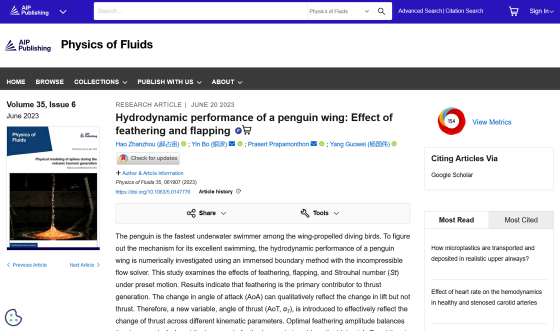Research results that the reason why penguins can swim quickly in water is in a special 'wing'

Although penguins are birds, they can swim at a very fast speed in the water, and among them
Hydrodynamic performance of a penguin wing: Effect of feathering and flapping | Physics of Fluids | AIP Publishing
https://doi.org/10.1063/5.0147776

Penguin Propulsion: The Physics Behind the World's Fastest Swimming Birds - AIP Publishing LLC
https://publishing.aip.org/publications/latest-content/penguin-propulsion-the-physics-behind-the-worlds-fastest-swimming-birds/
What makes the Gentoo penguin the world's fastest swimming bird? • Earth.com
https://www.earth.com/news/what-makes-the-gentoo-penguin-the-worlds-fastest-swimming-bird/
The physics of how gentoo penguins can swim speedily underwater | Ars Technica
https://arstechnica.com/science/2023/07/the-physics-of-how-gentoo-penguins-can-swim-speedily-underwater/
Penguins are creatures that give the impression of waddling around on land, but in water, they skillfully swim around with movements that combine speed and mobility. Such penguin wings do not have a structure for flying in the air, and play a role like fins that swim around in the water.
In general, aquatic organisms generate thrust in the water, so they adopt either a movement called 'rowing' like rowing a boat or a movement called 'flapping' like flapping wings. Rowing using drag is suitable for slower movement, and flapping using lift is suitable for faster movement.
Penguin wings are shorter and flatter than those of flying birds, and are covered with scaly feathers. Thanks to the dense scale-like feathers, it is possible to store air between the skin and the water, which seems to reduce friction and turbulence in the water that becomes resistance when swimming. .

In addition, the research team combined video of the penguin swimming with 2D motion analysis to build a hydrodynamic model that simulates the complex forces and flows around the wing. An analysis was conducted to find out how penguin wings produce thrust underwater.
The hydrodynamic model incorporated parameters such as thrust, lift, and lateral forces due to wing movement, as well as parameters related to fluid viscosity and velocity. In addition, we modeled the movement of the wing using the ratio of the flapping speed and the forward speed of the wing, and also introduced a new variable called 'angle of thrust', which consists of the angle of the wing with respect to the direction of travel.
As a result of the analysis, we concluded that penguins have a lift-based propulsion mechanism when swimming underwater, and a movement called '
Prasert Prapamonthon, co-author of the paper and a researcher at King Mongkut's Institute of Technology Latkrabang, said, 'Penguins' excellent swimming abilities, such as start/brake, acceleration/deceleration and turning, are due to their freely movable wings. Thanks to this wing, the penguin can demonstrate propulsion and mobility in the water, and can maintain balance on land.'

The results of this research not only provide a physical explanation of penguin swimming ability, but also provide hints for developing efficient underwater propulsion methods. This will provide clues for building state-of-the-art water vehicles and underwater exploration robots.
Related Posts:







